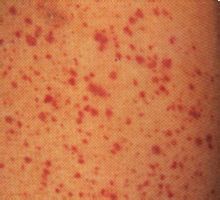美国如何最佳治疗儿童特发性血小板减少性紫癜

美国希望之光医疗原创,欢迎转载并注明出处
咨询日期:2016年10月18日
年龄:7岁
性别:女
诊断:特发性血小板减少性紫癜
病史总结:
患儿于2016年4月21日血常规显示:白细胞 6900/微升, 分类正常,血红蛋白14.3克/升,血小板27000/微升,无平均血小板体积数值。于2016年4月21日至4月26日住院诊治。多次血常规显示血小板减少,其他指标正常。临床诊断为特发性血小板减少性紫癜。于2016年4月22日开始每天一次的静脉甲泼尼龙琥珀酸钠40毫克注射治疗(1.6毫克/千克体重)。2016年4月25日骨髓检验报告:三系正常,无原始细胞,巨核细胞轻度增生。4月25日复查血常规,血小板升至148000/微升。出院后予以口服泼尼松25毫克一次,每天两次的治疗。
患儿继续门诊部随诊。2016年5月至6月,患儿的血小板数目正常。口服泼尼松的剂量从2016年5月4日起逐渐缓慢减量。2016年8月2日,她再次出现血小板减少,血小板数26000/微升。治疗药物泼尼龙改为地塞米松,血小板数目反应良好。2016年9月20日,最近一次的血常规显示血小板数目为96000/微升。
咨询建议:
患儿父母对患儿的诊断、化验结果、治疗方案、药物副作用、日常活动量、饮食和总体的预后进行了咨询。
- 孙教授支持特发性血小板减少性紫癜的诊断,理由如下:1)血常规和骨髓检验结果:血小板单系减少,细胞分类正常,骨髓形态和细胞学正常,仅有巨核细胞的轻度增生。2)她对激素治疗敏感。补体C3/C4的异常和抗核抗体弱阳性无显著临床意义。
- 美国的特发性血小板减少性紫癜的治疗方案选择:
在美国,治疗方式可以是观察或是药物治疗。总体上,由于血小板数目小于1万/微升可以增加自发性出血的风险,这类病人我们会治疗。而对于血小板数目大于2万/微升的病人,由于严重出血的风险极低,我们一般不予治疗。对于血小板数目在1万到2万/微升的病人,我们可以选择治疗或观察。
观察疗法的理论依据是减少药物治疗相关的不良反应,同时 不增加严重出血的风险。它是基于血小板数目和患者出血倾向的平衡措施。
在美国,我们一般应用静脉注射免疫球蛋白作为治疗特发性血小板减少性紫癜的一线方案。偶尔,我们也用抗Rho(D)免疫球蛋白作为一线用药。类固醇激素一般作为二线用药(偶尔用于一线)。激素治疗一般是大剂量起始,1-2周后开始逐渐减量。
- 类固醇激素与静脉注射免疫球蛋白的副作用
类固醇激素:短期副作用包括体重增长、情绪波动、失眠、高血糖、乏力和偶尔的疼痛;长期副作用包括其对生长和骨密度的影响。
静脉注射免疫球蛋白:输注血液/血浆制品有经血液途径传播疾病的风险,但其风险极小。
- 如果患者对治疗反应不佳,或出现反复的血小板减少,我们会进行骨髓检验排除其他病因。
- 特发性血小板减少性紫癜的自然病程
无论采用治疗还是观察方案,大多数儿童可自愈。大多数儿童一般会在发病后的12至18月内自愈。如果患者在发病后的12至18个月之后仍有血小板减少表现,则应诊断为慢性特发性血小板减少性紫癜。
- 慢性特发性血小板减少性紫癜的治疗方案(药物治疗或观察)取决于血小板数目和患者的活动量。
- 在美国如何治疗具有类似病史的患者:
患儿、患儿家属和医疗团队共同设定一个需要治疗的血小板最低数值-一般我们用1万-2万/微升(患儿母亲提出3万/微升)。
我们会开始对激素逐渐减量,一般需要2至3个月。如果患者血小板数目在激素减量期间明显降低,可以用静脉注射免疫球蛋白来补救治疗。
开始补充钙和维生素D。
- 根据血小板数目调整日常活动量
小于1万/微升:开始治疗;
1万-3万/微升:避免有直接身体接触的运动, 如曲棍球、篮球、足球、拳击, 避免乘坐过山车;
3万-5万/微升:避免拳击运动及用头直接击球;
大于5万/微升:无限制。
Medical History Summary:
Patient had a routine CBC on 4/21/2016 that showed WBC 6.9K, normal differential, Hb 14.3, Platelet 27K, no MPV available. She was hospitalized from 4/21-4/26/16. Multiple CBC showed normal finding except thrombocytopenia. She was diagnosed with ITP and was started on solumedrol 40mg IV (~ 1.6mg/kg) daily on 4/22. Bone marrow exam on 4/25/2016 showed normal trilineage maturation, no blast and slightly increased magakaryocytes. Repeat CBC on 4/25 showed platelet counts of 148K. She was discharged home with prednisone 25mg po bid.
She was followed up as outpatient. She had normal platelet counts in May and June. From the records, prednisone dose reduction started on 5/4/16. It was taped down slowly. She was found to have thrombocytopenia again on 8/2 with platelet count of 26K. Prednisone was changed to dexamethasone and platelet count responded well. The last CBC showed platelet counts of 96K on 9/20/2016.
Recommendations:
Parents have questions about her diagnosis, test result, treatment plan, side effect, activity, food, and overall outcome.
- I agree with the diagnosis of ITP, based on the following: 1) CBC and bone marrow exam results – isolated thrombocytopenia, normal differential, normal marrow cellularity/morphology, except slightly increased megakaryocytes. 2) She also responded to steroids very well. The slightly abnormal C3/C4 and weakly positive ANA are not clinically significant.
- Treatment options for ITP in the US
In US, the treatment can be: observation and medication. In general, we will treat patient if PLT < 10K due to the risk of increased spontaneous bleeding; we generally do not treatment patient if PLT > 20K since the risk of severe bleeding is extremely low; if PLT is 10-20K, we can treat the patient or opt to observe.
Rationale for observation – decrease the side effect associated with treatment, at the same time to not increase the risk of severe bleeding. It is a balanced act based on the platelet count and the bleeding tendency of the patient.
In US, we generally use IVIG as first line to treat ITP. Occasionally, we also use WinRho as first line. I explained to family how IVIG and WinRho work. Steroids is generally used a second line (occasionally first line). We generally start steroids at large dose for 1-2 weeks, then start to taper.
- Side effect of steroids and IVIG
Steroids: short term side effect include: weight gain, mood swing, insomnia, hyperglycemia, weakness and occasionally pain; long term side effect including growth, bone density.
IVIG: risk of transmission of disease through blood/plasma product. However, the risk is extremely low.
- If a patient doesn’t respond to the therapy well, or recurrent thrombocytopenia, we will do bone marrow exam to rule out other causes.
- Nature course of ITP
Most children will recover spontaneously, irrespective of therapy or observation. In general, most children will recover within 12-18 months. If patient still presented with thrombocytopenia beyond 12-18 months, we will consider the diagnosis of chronic ITP.
- The treatment indication (vs. observation) of chronic ITP will be based on the PLT count and patient activity level.
- I discussed with family how we usually manage a patient with similar history in the US:
Work with the child, family, and medical team to set up a comfortable minimal platelet counts that will require treatment – in general, we use 10-20K (mother mentioned she is happy with 30K).
We will start to taper the steroids slowly, approximately 2-3 months. If patient platelet counts dropped during taper, can use IVIG as rescue.
Start Vitamin D and Calcium。
- Modify activity based on the PLT count
< 10K: treatment.
10-30K: avoid contact sport such as Hockey, basketball, football, boxing, avoid roller coaster.
30-50K: avoid boxing and use head to hit ball directly.
50K: no restriction.

